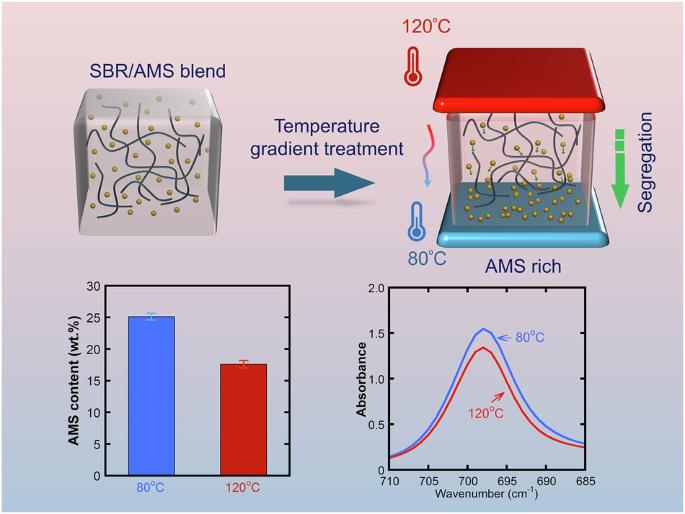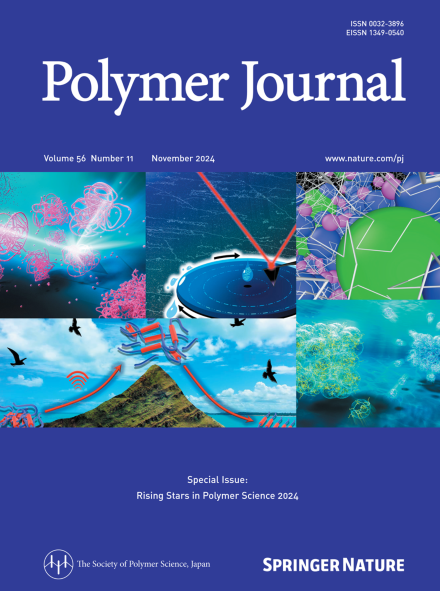温度梯度下胶黏剂在丁苯橡胶中的偏析行为
IF 2.7
4区 化学
Q3 POLYMER SCIENCE
引用次数: 0
摘要
采用丁苯橡胶(SBR)和增粘剂(主要由苯乙烯和α-甲基苯乙烯(AMS)组成的低聚共聚物)共混共混物,研究了温度梯度下的结构发展。研究发现,在低于120℃的温度下,AMS的含量高达30 /百橡胶(phr) (23 wt.%)时,AMS可以与SBR相混。将厚度为1 mm的共混板放入压模机中,在压模机中,将顶板和底板分别保持在120°C/80°C和100°C/60°C的不同温度。30min后,对两表面的AMS含量进行表征。在无相分离的情况下,低温侧AMS含量高,低温侧AMS含量低。研究了SBR/AMS共混物的相图随共混物组分和温度的变化规律。该体系表现出较低的临界溶液温度行为,表明Flory-Huggins相互作用参数随温度升高而增加。因此,在低温下,含有大量AMB的共混物必须具有较低的自由能,这可能导致暴露于温度梯度后表面的不同组成。详细研究了温度梯度下丁苯橡胶(SBR)与聚α-甲基苯乙烯(AMS)的偏析行为。发现SBR和AMS在AMS含量为30 phr (23 wt)时可混溶。%),经动态力学分析证实。通过衰减全反射-傅里叶变换红外光谱(ATR-FTIR)检测,在温度梯度下处理后,观察到AMS向暴露在较低温度下的表面偏析。基于SBR/AMS系统的相图进一步阐明了其潜在机理。本文章由计算机程序翻译,如有差异,请以英文原文为准。

Segregation behavior of a tackifier in styrene-butadiene rubber under a temperature gradient
Structure development under a temperature gradient was studied using a miscible blend of styrene-butadiene rubber (SBR) and a tackifier, an oligomeric copolymer comprising mainly styrene and α-methyl styrene (AMS). AMS was found to be miscible with SBR at an AMS content of up to 30 parts per hundred rubber (phr) (23 wt.%) at temperatures below 120 °C. A blend sheet with a thickness of 1 mm was placed in a compression-molding machine, where the top and bottom plates were maintained at different temperatures, such as 120 °C/80 °C and 100 °C/60 °C. After 30 min, the AMS contents on both surfaces were characterized. The AMS content on the low temperature side was high, and vice versa, with no phase separation. Furthermore, the phase diagram of the SBR/AMS blends as a function of the blend composition and temperature was examined. The system was found to show lower critical solution temperature behavior, suggesting that the Flory–Huggins interaction parameter increases with temperature. Therefore, at low temperature, blends containing large amounts of AMB must have a low free energy, which may result in the different compositions of the surfaces after exposure to a temperature gradient. The segregation behavior of Styrene-Butadiene Rubber (SBR) and poly(α-methylstyrene) (AMS) under a temperature gradient is investigated in detail. SBR and AMS are found to be miscible at an AMS content of 30 phr (23 wt.%), as confirmed by dynamic mechanical analysis. After treatment under a temperature gradient, AMS is observed to segregate toward the surface exposed to the lower temperature, as detected by Attenuated Total Reflectance-Fourier Transform Infrared Spectroscopy (ATR-FTIR). The underlying mechanism is further elucidated based on the phase diagram of the SBR/AMS system.
求助全文
通过发布文献求助,成功后即可免费获取论文全文。
去求助
来源期刊

Polymer Journal
化学-高分子科学
CiteScore
5.60
自引率
7.10%
发文量
131
审稿时长
2.5 months
期刊介绍:
Polymer Journal promotes research from all aspects of polymer science from anywhere in the world and aims to provide an integrated platform for scientific communication that assists the advancement of polymer science and related fields. The journal publishes Original Articles, Notes, Short Communications and Reviews.
Subject areas and topics of particular interest within the journal''s scope include, but are not limited to, those listed below:
Polymer synthesis and reactions
Polymer structures
Physical properties of polymers
Polymer surface and interfaces
Functional polymers
Supramolecular polymers
Self-assembled materials
Biopolymers and bio-related polymer materials
Polymer engineering.
 求助内容:
求助内容: 应助结果提醒方式:
应助结果提醒方式:


